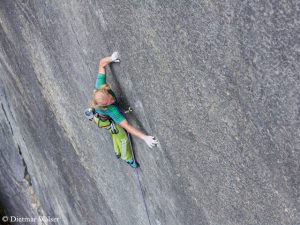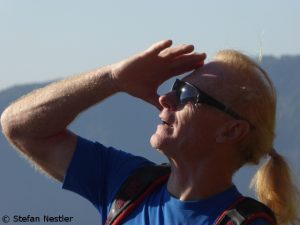Beat Kammerlander: “It’s always about wanting”
The 59-year-old is a phenomenon, a living climbing legend: Austrian Beat Kammerlander is still overcoming vertical walls, almost without climbing grips – preferably in the Rätikon, quasi on his own doorstep. The Vorarlberg native lives with his wife Christine and their two children in the city of Feldkirch. A week ago, at the “International Mountain Summit” (IMS) in Brixen, Kammerlander received the renowned “Paul Preuss Award“, which honours climbers who stand in the tradition of the free climbing pioneer who fell to his death in 1913. Preuss had pleaded for a far-reaching renunciation of climbing equipment such as ropes or bolts (“Skill is the measure of what is allowed.”). “Actually, the award could also be called the ‘Beat Kammerlander Award’,” said Hanspeter Eisendle from South Tyrol, winner of the prize in 2013, in his laudation. I spoke with Kammerlander during the IMS.
Beat, next year you’ll be 60 years old and you’re still climbing crazy tours. Will you tell us the secret of your success?
There’s no secret. Do what you love! Only that counts. (laughs) I once planned to continue with this competitive sport until I was 40. Then I turned 40 and was stronger than before. Then I said: Why should I stop now doing something I like best? Over the years there have been setbacks, stagnation, injuries, but also highlights again and again. I realized that I feel much better about the way I lead my life and how I can finance it than if I did any job. And I am allowed to go climbing. So this question has become superfluous. Now I will soon turn 60, that’s just a number. What matters is how I feel.
While last year was great, this year was not a good one. I was bitten by a tick, got Lyme disease and had to be treated. That kept me pretty small over the summer. Now I have to be a stand-up man. I am well again. But I still need a few more months with targeted training and physiotherapy so that I can climb again on a very high level.
Have you been ordered to rest?
No, but I have a family with two small children. Sarah is two and a half, Samuel turns five in February. I spend a lot of time with them. In the past I used to goof around far too much and to train senselessly. My time management is much more targeted now. It suits me very well.
In 2017, you opened a new extremely difficult route in the Rätikon and called it “Battle Zone”. Do you have to fight more today than in the past?
You always fight as good as you can, at any time. (laughs) Depending on the type. Maybe I even developed a bit more motivation on this route than I used to, more consistency to achieve this goal. It was so difficult to open this route from bottom to top and to set the bolts, then to climb the passages freely. And finally it was about climbing the route Redpoint, in one day these five pitches of high difficulty. 10+, 11-, 10-, 8 and 9+. It requires a very high intensity to connect these pitches. For this project, I once again chastened myself extremely and prepared myself in a very special way. Even in the most adverse weather conditions I went there and didn’t waste any time. I also went out in the rain. I knew that it was windy on the other side of the mountain and that the fur would get dry. The whole thing at 2,800 meters, in a summit region where it always blows. You have to wrap up warm and still climb – and don’t say: Today I don’t feel like it, today I’m too comfortable. It’s always about wanting.
Does being able to bite through make you stand out?
Probably.
Do you need that to stay in business that long?
I rather see that being allowed to bite through. I have fun doing it. Surely it’s sometimes painful to hold such small grips. But it’s nice to be able to decipher such smooth, small-grip rock and climb it. If you are the first to tackle this rock and leave a trace, a line there. That is my motivation.
Even after such a long time? Doesn’t there ever come a point at which you say: Now it’s enough?
I’m not on the road every day. Spread over the year, it’s just a few days you work towards – mentally and physically, until you get released like a racehorse.
To be such a racehorse, do you also need competition with other climbers?
No. That would be so repugnant to me. I only do that for myself. I don’t want to compete with others. I don’t give a damn.
But climbing in a team is something important for you, isn’t it?
Of course. I only climb with friends, otherwise it doesn’t work. It’s a give and take. It’s a real act of friendship if someone joins you who is not able to climb these difficulties. You have to be grateful when a good friend is belaying you the whole day on a first ascent and feels sorry for you. And who is always on the ball. Because if he doesn’t belay you well, you can be injured seriously.
Has your role shifted in the decades, from greenhorn …
I wasn’t a greenhorn for long. (laughs)
… to mentor?
Of course. I have a big climbing scene around me and have shaped it very much in terms of ideology and attitude: That you have to be honest and say what you did and how you realized it.
Do you think that the problem of a lack of honesty increases in times of marketing?
Sure. You can dream a lot of climbing projects up that aren’t really worth anything, but that make a good headline above a bad report. You will then have received your media echo, and that won’t be revoked. However, you have a loss of image which you also have to live with.
You have opened most of your routes in Europe. Why did you never go to the very high mountains in the Himalayas or the Karakoram?
That just didn’t happen. My projects, which were constantly present, simply kept me here. I would have had the motivation and the interest to climb the high walls of the Karakoram, but now that’s passé.
Let’s talk about risk. How much risk are you willing you take?
I believe that my routes, in the way I climbed them, are relatively safe. On some of my previous routes the risk was of course much higher, for example when I was doing free solo ice climbing or difficult routes in sport climbing. But alpine sport climbing is about the awareness you have developed. I am not someone who flees from a dangerous situation as quickly as possible. I have the necessary patience and the mental power too. Again and again up and down, until I manage it. Many people can’t stand it and then make the fatal mistake.
Have you ever been lucky while climbing?
Of course. Frequently.
And what did that teach you?
Above all, to be careful with routine matters. Or when stupid emotions come along. Then sometimes you do fooling things. And that’s not smart.
Has your father role also had an effect in terms of risk taking?
When I’m out freeriding as a mountain and ski guide with guests or even for myself, it’s actually the big dangers I’m afraid of. Sometimes you can’t judge a flank’s risk exactly. Then you stand somewhere up there and have to go down. You can keep the alpine safety rules, but every now and then you also need your portion of luck. I have become much more cautious than before.
Would you encourage your children if one day they came and said: We want to do the same as you?
Of course. Do what you love! But I never want to manipulate anyone in one direction. That must come by itself.
And you have the feeling that all your life you have done what you wanted?
I think so. (laughs)













